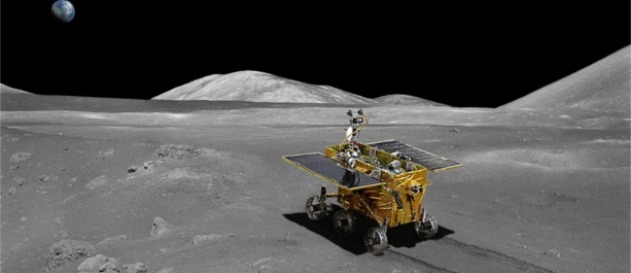
Three days ago, China's Jade Rabbit rover landed on the moon, marking the first time in four decades that mankind has successfully executed a lunar soft landing. Jade Rabbit will be in operation for about three months, and it wasted no time in beaming pictures back to Earth. There's been a flood of terrific imagery, but I've found myself most compelled by the video above, which shows the lander's descent. Even though we know this clip depicts "real" events (or do we...), in silky black and white taken from the lander's perspective, the moon's surface looks fake and plasticine, the motion we're seeing jerky and unnatural. There's the curious moment at about :31 seconds in where the lander's descent seems to stall entirely (signaling the deployment of a parachute perhaps?) and another at :43 where there's a brief burst of light (some sort of upward thrusting rocket meant to slow the descent further?). Then, in a surprise move, the black and white gives way to color and we see the Jade Rabbit rover itself as it rolls away across the surface of the moon, leaving tracks behind it. This miraculous feat is a thing that human beings like you and I (but smarter) accomplished, and the Chinese made sure to provide multiple cameras to best memorialize the event.
Imagining what a moon landing might look like was one of the first tasks the pioneers of cinema set before themselves--Georges Méliès sent some intrepid travelers there as early as 1902, only seven years after the medium came into existence.
It would be 67 years before we'd get to see an actual moon landing.
And, 42 years after that, Michael Bay's Transformers series would make an artistic leap that smashes Méliès-esque fantasy and actuality together. Transformers: Dark of the Moon re-imagines the Apollo 11 landing as the locus of a massive conspiracy, one in which Armstrong and Aldrin, after making their historic landing, scamper off over a nearby ridge to investigate a massive robot spaceship. To create this sequence, Bay freely intercuts archival footage from the landing into his created material (some of which is colored to read as "period," throwing registers of the real into event more confusion) creating a seamless alternate history in which cinema seduces the viewer to abandon historical memory, even as we watch actual historical records.
This sequence is the most audacious thing Bay has yet put on film (and is the only section from the six hours of Transformers movies worth discussing), and suggests again the myriad ways in which records of scientific endeavors permeate entertainment and vice versa.
Would the Chinese scientists behind Jade Rabbit have plotted a multi-camera shoot to record their achievement without cinematic language showing them the value of different angles? Perhaps they would have--the sheer obviousness suggests a kind of generative grammar of the moving image one plumbed grappled with equally by Méliès, Bay and a bunch of scientists in a lab hoping to make the next great leap for mankind.
TOPICS